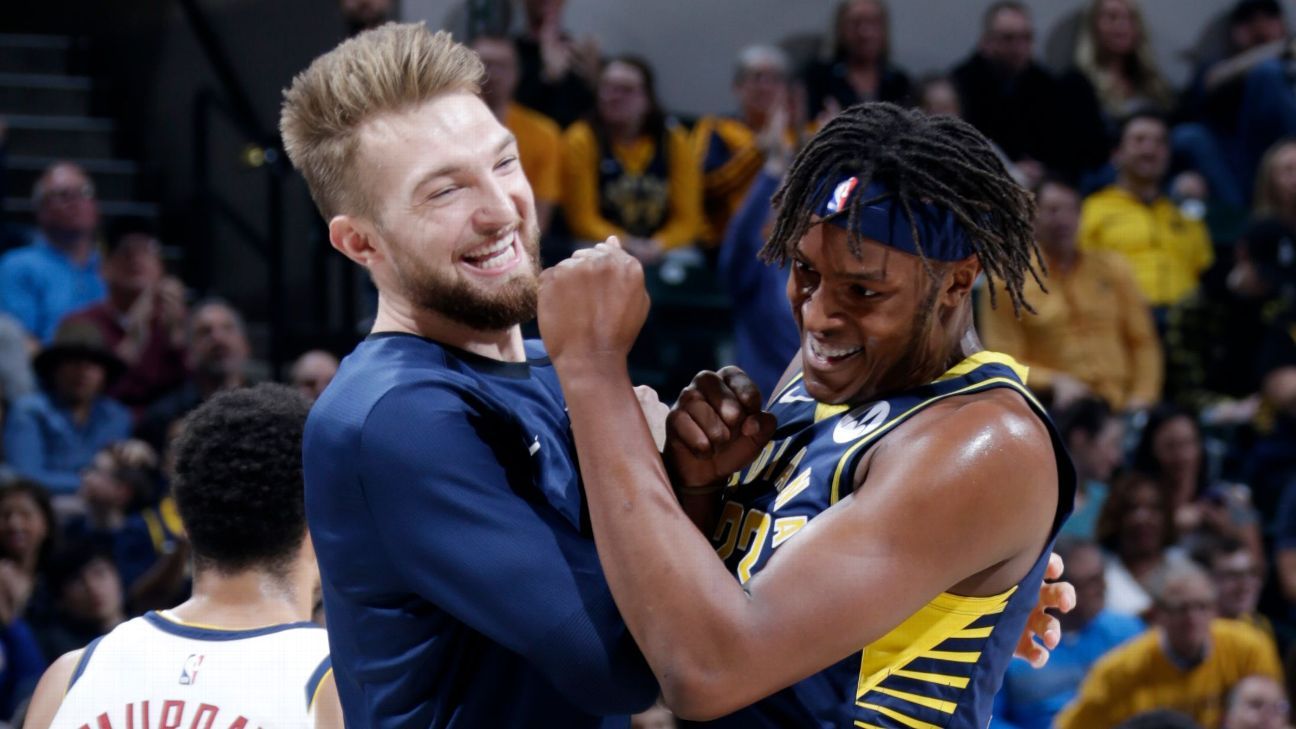INDIANAPOLIS — In a quiet moment after his team finished up practice Thursday afternoon, Indiana Pacers forward Thaddeus Young was asked a question: Do you ever, even for a second, think about what this series against the Boston Celtics would look like if Victor Oladipo — who has been sidelined with a ruptured quad tendon since Jan. 26 — was healthy and able to play in the series?
“I try not to,” Young said with a smile, and a rueful shake of his head.
“This is why you have a guy like Vic,” he continued. “You have a situation where you have guys switching onto Vic. Bigger guys. We know what Vic does. He’s gonna back it out to half court, take two or three dribbles in, go up for his midrange jumper or his 3. Make him [the defender] feel those. Now you start to pressure up. Go by him, get a few layups. Get a couple fouls, and-1s. And now you double-team. Now that’s when everybody else takes over.”
Anyone who has watched the Celtics take a 3-0 lead in this series would agree with Young’s assessment. The Pacers are a team built in a very specific, calculated manner: hard-nosed, hardworking guys who work well together, play stifling defense and give the ball to Oladipo — their closer — to carry them home. But Oladipo’s absence has loomed large.
The Pacers are one more loss to the Celtics away from beginning their offseason, when they’ll be forced to address the gap between them and the Celtics, the Milwaukee Bucks and the other top teams in the East. When they do so, one question will loom over almost every decision the Pacers have to make: Can their two emerging young big men, Myles Turner and Domantas Sabonis, play together?
And, if they can’t, can Indiana afford to keep them both?
“I think we’re making all the right moves, and bringing in all the right guys,” Turner said. “This summer’s obviously big, [because of] free agents and whatnot, [but] I think we’re doing a good job of setting up our future.”
As of now, the Pacers’ future has more questions than answers. While it is unclear when Oladipo will return, the Pacers have no choice but to operate under the assumption that he will return to All-Star form when he does. Indiana also has six key players — current starters Darren Collison, Wesley Matthews, Bojan Bogdanovic and Young, as well as top reserves Cory Joseph and Tyreke Evans — who will be unrestricted free agents this summer.
Then there are the futures of Turner and Sabonis in Indiana, which directly impact everything else. For teams in bigger markets, the answer would be simple: pay them both, and keep two talented players.
Things in the NBA are rarely simple, though, and this is no exception. Herb Simon, Indiana’s longtime owner, isn’t likely to green-light the Pacers going near the luxury tax anytime soon, which makes it difficult for their front office — led by president of basketball operations Kevin Pritchard and general manager Chad Buchanan — to commit significant contracts to a pair of centers who don’t easily fit together on the court.
One half of that equation has already been determined, as Turner and the Pacers agreed to a four-year, $70 million contract extension last fall. Turner rewarded that investment by taking a significant step forward this season, leading the NBA in blocks and earning himself All-Defensive Team consideration.
“It’s a blessing to be able to just play loose, play just free basketball and just know there’s not that much pressure on you,” Turner said. “It’s easy to fall into that little lapse where you just feel like you have to overdo it or feel like you have to overdo it just the things you’re not capable of doing.
“Getting it done early definitely alleviates some of the nerves.”
It also did something else: set a baseline for negotiations this summer with Sabonis, who will be extension-eligible ahead of his own restricted free agency next summer. Comparing the two players is far from an apples-to-apples thing. Turner is the bigger, longer and more athletic of the two, as his block numbers would suggest, while Sabonis, the son of Hall of Fame center Arvydas Sabonis, is the much more well-rounded one of the two offensively, and plays with a toughness and edge that scouts are drawn to. It’s likely Sabonis will be able to command a similar dollar figure.
The fact that next summer’s free-agent class (at least after Anthony Davis) is far weaker than this summer’s star-studded class doesn’t hurt Sabonis’ case, either.
But despite each of their intriguing talents, Sabonis and Turner both are almost universally considered centers. The general trends of where the league is headed make it difficult to play them together on a regular basis — though Sabonis thinks, in time, that will change.
“It’s been great,” Sabonis said of playing with Turner. “Every game we feel more comfortable together. We both want to win and we just want to get things done. I think me and him greet each other well on the court. I think the more the coaches trust us to play more on the court, that’s the only way you can improve.”
Given the decision that lies ahead for Indiana, it should come as no surprise the Pacers tried to play Turner and Sabonis together whenever possible this season. During the regular season, the strategy had some success: Indiana outscored its opponents by 3.1 points per 100 possessions across 429 minutes the two played together — an average of a little less than seven minutes in each of the 64 games it was used.
This series against the Celtics, though, has highlighted the pairing’s potential downside. The Pacers have been outscored by 17 points (54-37) in the 24 minutes Turner and Sabonis have played together against the Celtics. On a per-possession basis, the numbers look even worse: Indiana is being outscored by 34 points per 100 possessions when they share the court together.
“Yeah, I mean, obviously it’s gonna be tough, because of the way most forwards are built,” Young said, when asked how Turner and Sabonis fit together.
“But, at the end of the day, I think they’ve done well together in certain instances. I think it’s about personnel and matchups.”
Young is right, of course — which is why he is a better fit next to both of them, and is expected to be a priority for the Pacers to retain this summer. But that only underscores the difficult predicament that Indiana now finds itself in when it comes to trying to plot out its future.
“The question I have with Sabonis and Turner is can they play together,” one Western Conference executive said. “I don’t think so, [but] that’s me.
“I think they’re both centers, and so you’re going to have to be financially committed to one.”
The beauty of going through the crucible of a playoff run in the NBA is that it shines a light on all aspects of a team — both good and bad. That the Pacers have been able to show as much fight, grit and determination as they have both this year and last in the postseason is an undeniable positive.
But, ultimately, it hasn’t been good enough. And now, as Indiana stares at the cold reality of a rapidly approaching offseason full of significant decisions, none will be bigger than the choice the Pacers might be forced to make between their talented young big men.

